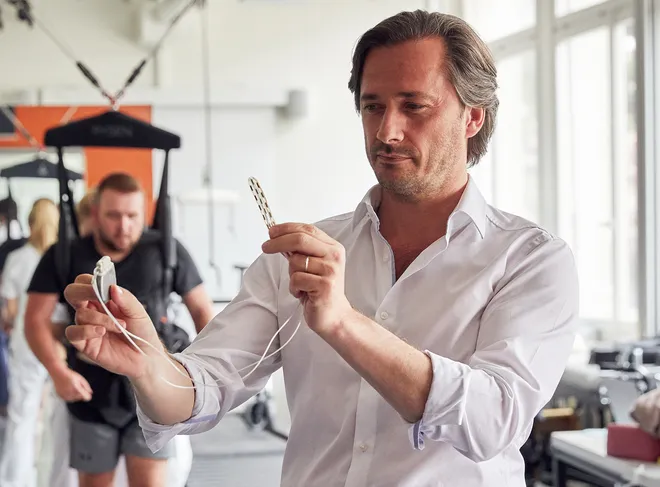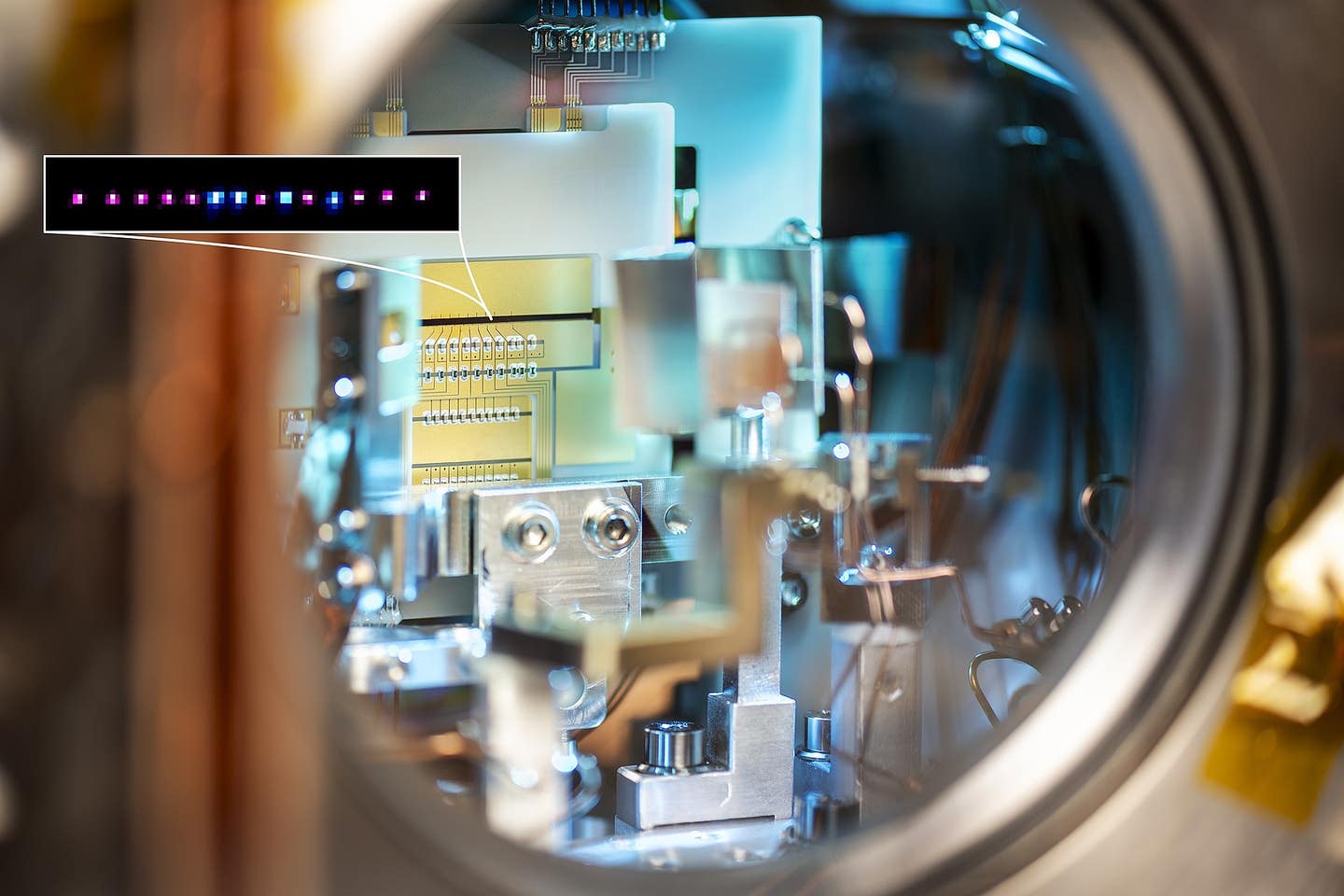First-ever spinal cord implant helps patient with Parkinson’s disease walk
A pioneering spinal cord stimulation technique has shown promising results in treating the debilitating effects of Parkinson’s disease.

[Nov. 9, 2023: Staff Writer, The Brighter Side of News]
Grégoire Courtine holds up the array that's implanted on the spinal cord of paralyzed patients. (CREDIT: Rolex Audoin Desforges / École Polytechnique Fédérale De Lausanne)
In a remarkable scientific breakthrough, a pioneering spinal cord stimulation technique has shown promising results in treating the debilitating effects of Parkinson's disease. Marc Gauthier, a former architect and small-town mayor, had struggled with Parkinson's for years, facing frequent falls and loss of independence. However, a cutting-edge spinal cord stimulator has transformed his life, allowing him to regain his mobility and improve his quality of life.
The groundbreaking study, published recently in the journal Nature Medicine, reports on the success of this innovative approach in treating Parkinson's disease. Gauthier, who resides in a renowned wine-producing region in France, volunteered to be the first-ever recipient of this spinal cord stimulator, and his remarkable progress serves as a beacon of hope for countless individuals affected by this neurodegenerative disorder.
Parkinson's Disease: A Formidable Foe
Parkinson's disease is a neurodegenerative disorder that primarily afflicts individuals over the age of 60, although it can manifest earlier in some cases. Characterized by a range of symptoms, including involuntary movements, stiffness, balance issues, and coordination difficulties, Parkinson's poses significant challenges to those it afflicts. Additionally, it can result in speech problems, mental and behavioral changes, sleep disturbances, depression, memory loss, and fatigue.
Related Stories
Typically, the initial treatment for Parkinson's involves medications aimed at replenishing dopamine, the neurotransmitter that is depleted in Parkinson's patients. For patients with progressive symptoms, deep brain stimulation (DBS) implants can provide relief, particularly for hand tremors. Marc Gauthier's journey to recovery began two decades ago when he received his first DBS implant, an experience he described as his first rebirth.
However, as the disease continues to advance, many patients encounter gait issues that prove resistant to both dopamine treatment and DBS. This is where the spinal cord stimulator comes into play, offering a potential solution to address this challenging aspect of Parkinson's.
Spinal Cord Stimulation: A Tailored Approach
The spinal cord stimulator implanted in Marc Gauthier's lower back is designed to send precisely timed pulses of energy to his spinal cord. These pulses, in turn, transmit signals to the muscles in his hips and legs, restoring vital connections damaged by Parkinson's disease. This stimulation has proven instrumental in improving his balance and halting the common phenomenon known as "freezing" that plagues Parkinson's patients.
A device implanted in his lower back helps Parkinson's patient Marc Gauthier negotiate stairs. (CREDIT: WEBER Gilles)
To enhance the precision of this therapy, sensors have been strategically placed in Gauthier's shoes and on his legs and hips. These sensors continually detect residual movements and adjust the timing and location of the stimulation accordingly, facilitating his ability to walk and navigate stairs.
While the technology used in this spinal cord stimulator has been previously employed to enable select individuals with spinal cord injuries to regain mobility, researchers have spent five years adapting it to address the unique challenges posed by Parkinson's disease.
Jocelyn Bloch, a neurosurgeon at Lausanne University Hospital in Switzerland, is helping develop neuroprosthetic devices to enable people with spinal cord injuries to walk again and to improve the gait of people with Parkinson's disease. (CREDIT: WEBER Gilles)
Grégoire Courtine, a prominent neuroscientist who has led both efforts, emphasizes that the principles and technology employed in both applications are fundamentally similar. However, the difference for Marc Gauthier has been nothing short of dramatic. As Gauthier stated in a recent webinar, "I can now walk with much more confidence, and my daily life has profoundly improved."
Precise Timing and Customization
The key to the success of this spinal cord stimulation therapy lies in the precise timing and customization of the energy pulses. Jocelyn Bloch, the neurosurgeon at Lausanne University Hospital in Switzerland who performed Gauthier's groundbreaking surgery, likened the stimulator's function to that of devices used for decades to treat neuropathic pain. While the surgical procedure to implant the device is relatively straightforward, ensuring that the energy pulses are delivered with pinpoint accuracy is the real challenge.
Frenchman Marc Gauthier, 63, is the first person to ever receive a spinal cord stimulator to help treat Parkinson's disease. (Credit: WEBER Gilles)
Eduardo Martin Moraud, an expert in neuromodulation at Lausanne University Hospital, stresses the importance of proper stimulation parameters. Stimulating in the wrong manner or with incorrect patterns and parameters can adversely affect gait and overall mobility.
In Gauthier's case, whose gait was notably uneven, targeted stimulation significantly improved symmetry and balance. Courtine and Bloch, who co-direct the NeuroRestore center in French-speaking Switzerland, emphasize that the device augments and corrects deficits in Gauthier's movement while still allowing him full control. Gauthier can even turn the device off when sleeping or sitting for extended periods, and he experiences only a mild tingling sensation from the stimulator, which he finds non-intrusive.
The success of the spinal cord stimulator in Marc Gauthier's case has sparked excitement among researchers and healthcare professionals alike. A second patient has already received the implant and is showing early signs of improvement, although the results are yet to be formally documented.
Funded by the Michael J. Fox Foundation, the research team plans to initiate therapy with six more patients to gain a deeper understanding of individual responses to the stimulation and the potential variability in outcomes. Their ultimate goal is to scale up the technology through their company, ONWARD Medical, to make it accessible to a larger population of individuals suffering from Parkinson's disease and spinal cord injuries.
Grégoire Courtine articulates this vision, stating, "I only hope that we go from one to 1,000 (people). That is the mission we have: to make this available widely across the world."
While the researchers are cautiously optimistic about the potential of spinal cord stimulation to enhance the lives of Parkinson's patients, they acknowledge that this technology is not a cure. It cannot reverse the disease, but it can offer a significantly improved quality of life, as Marc Gauthier's experience attests.
Gauthier's wife is particularly delighted by his progress, as he can now go out unassisted, allowing her some much-needed time alone at home. It has been a challenging journey for Gauthier, filled with hard work and dedication, but as he reflects, "It wasn't a straight line, an easy line. It was a lot of work. But it was worth it."
The future holds promise for individuals battling Parkinson's disease, as innovative approaches like spinal cord stimulation offer renewed hope and the possibility of a better quality of life for those who have long endured its debilitating effects.
Note: Materials provided above by The Brighter Side of News. Content may be edited for style and length.
Like these kind of feel good stories? Get the Brighter Side of News' newsletter.
Joseph Shavit
Head Science News Writer | Communicating Innovation & Discovery
Based in Los Angeles, Joseph Shavit is an accomplished science journalist, head science news writer and co-founder at The Brighter Side of News, where he translates cutting-edge discoveries into compelling stories for a broad audience. With a strong background spanning science, business, product management, media leadership, and entrepreneurship, Joseph brings a unique perspective to science communication. His expertise allows him to uncover the intersection of technological advancements and market potential, shedding light on how groundbreaking research evolves into transformative products and industries.



